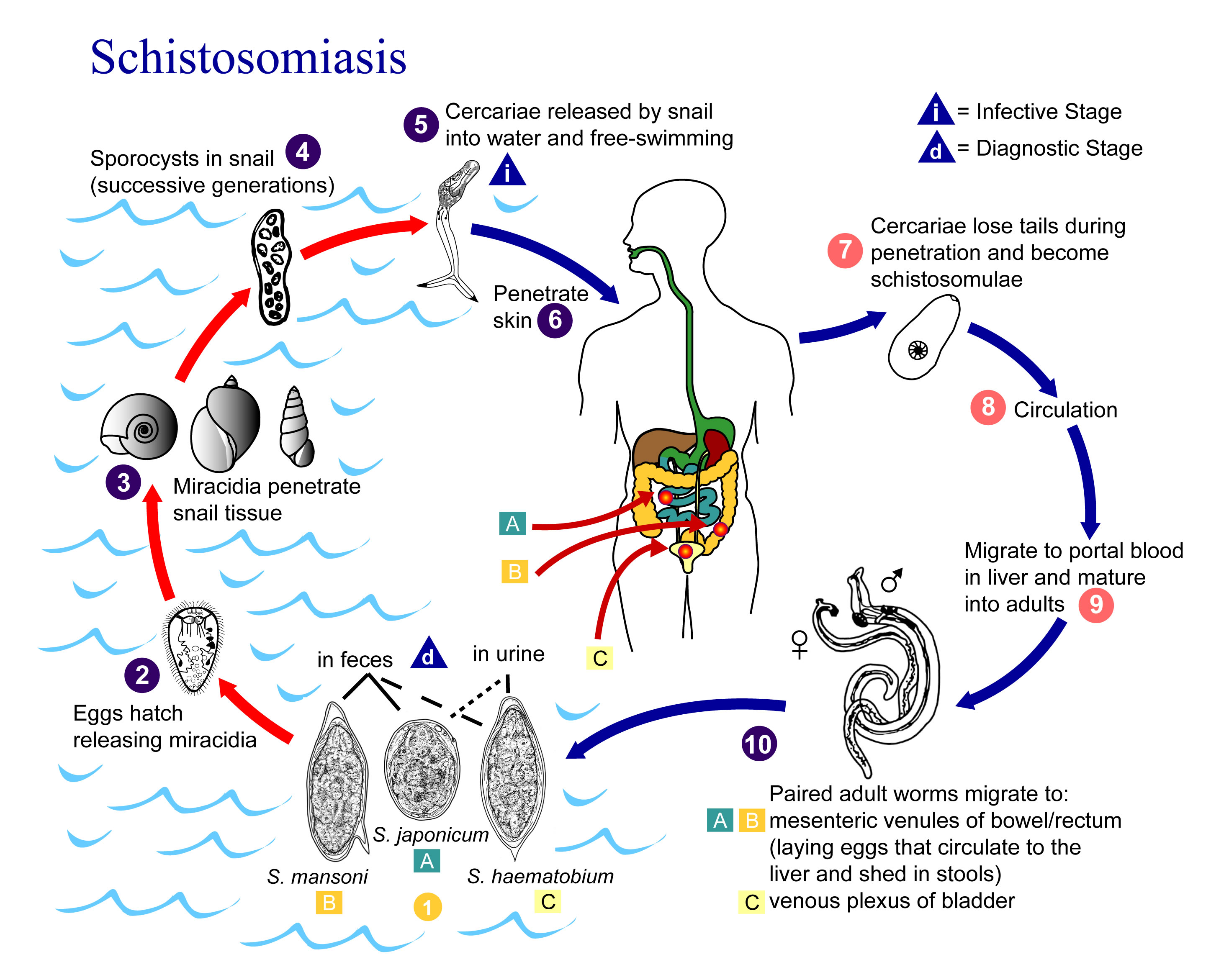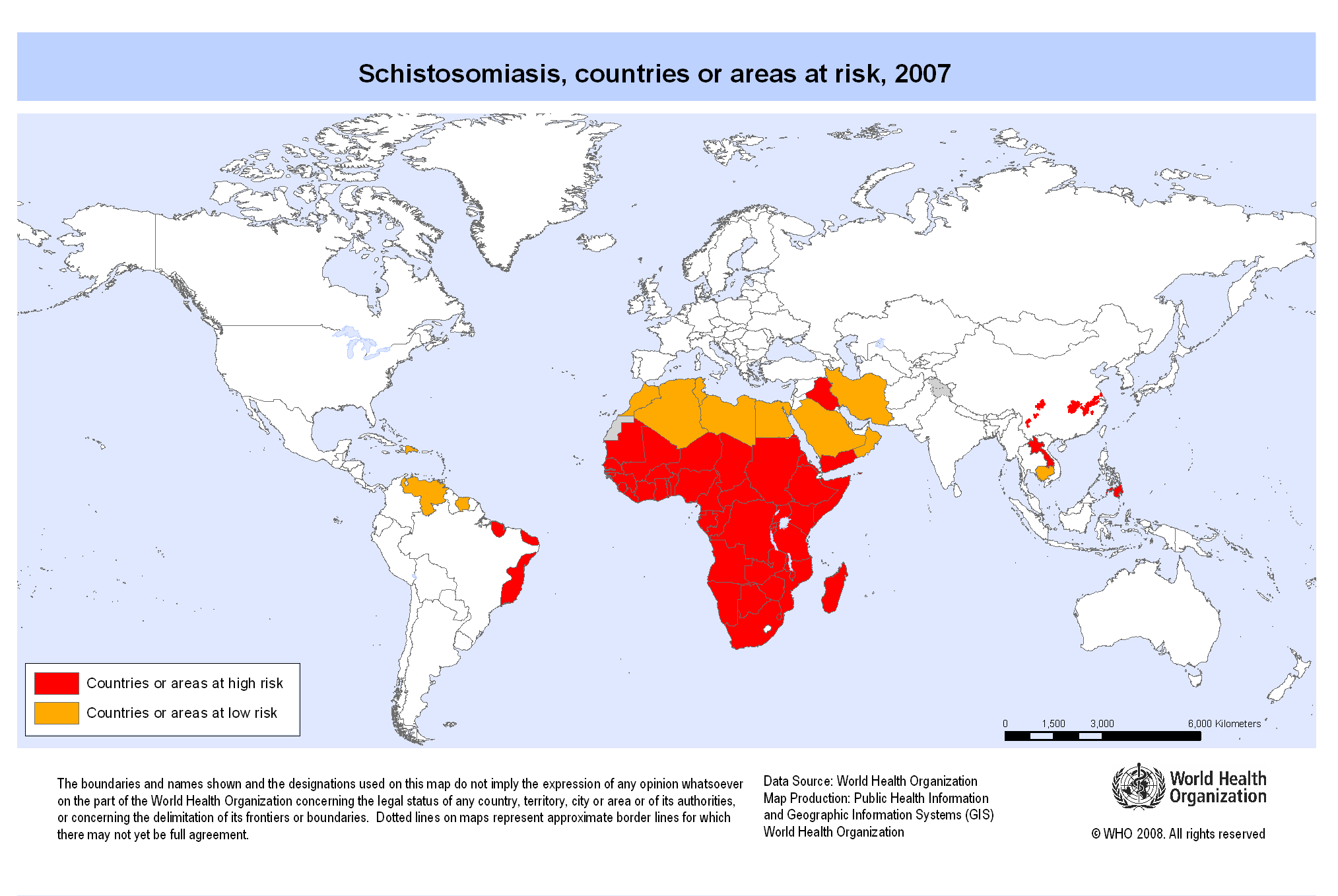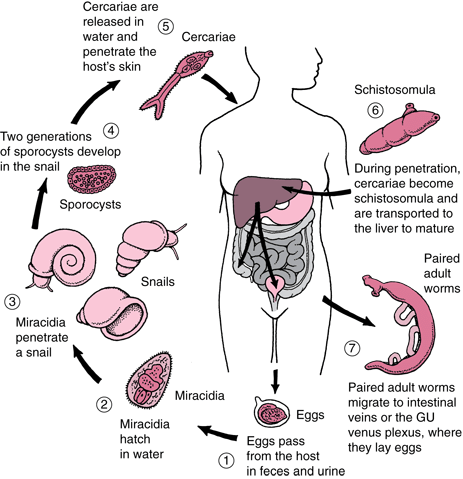Schistosomiasis
Schistosomiasis - also known as bilharzia - is a worm disease that is widespread in warm inland waters by snails as an intermediate host.
Pathogen
Pathogens are known as fluke ( Schistosoma ), a 1-2 cm long Saugwürmergattung ( Trematoda ). The released of the worm larvae penetrate on contact in contaminated ( contaminated ) water through the skin of humans and migrate via lymph and blood vessels in the liver, where they evolve. Then they spread through the veins especially in the bladder, intestines, liver, lungs and brain, as well as the precipitates in surface waters. An infection from person to person is excluded.
There are different causative agent of schistosomiasis known: Schistosoma haematobium, the causative agent of Blasenbilharziose in which mainly the urinary tract and the urinary bladder are affected. In contrast, causing the S. mansoni, S. intercalatum, S. japonicum and S. mekongi an intestinal infection. An extremely annoying infection with different Trichobilharzia species ( parasitized waterfowl) is known as Cerkarien or Cercaria Dermatitis, where for Trichobilharzia Regenti damage to the neurons and the central nervous system for humans can not be excluded.
Historical
The Blasenbilharziose may pop up as AAA disease is already in the ancient Egyptian Ebers Papyrus. The name of the disease goes back to the German physician Theodor tropical Bilharz who discovered the pathogen in autopsies in a Cairo hospital in 1851. First, the parasite was therefore named after its discoverer Bilharzia.
Epidemiology
The physician, bacteriologist and founder of Marc Armand Ruffer palaeopathology could prove the beginning of the 20th century in its systematic studies of thousands of mummies, mummy remains and skeletons that schistosomiasis was prevalent in ancient Egypt during the 20th Dynasty. They may be identical to the AAA disease.
The disease is now widespread in Japan, China, the Philippines, Africa, the Arabian Peninsula, South America, the Caribbean and the Middle East. It is estimated that about 250 to 300 million people infected with the parasite and 600 million are at risk. Due to dam construction (eg Aswan Dam in Egypt) and irrigation projects increases the risk of disease.
Disease process and signs
The first symptoms are itching at the site of entry of the larvae and the formation of a skin rash, called Cercaria Dermatitis. However, the cercariae can penetrate undetected through healthy skin.
Schistosoma haematobium then travels through the tissue and after about 3-4 weeks into the lungs, which can cause an allergic reaction with edema, hives, cough and fever, the so-called Katayama fever. The cercariae of Schistosoma haematobium then embed themselves in the bladder wall and put the eggs in the tissue. These eggs can penetrate the tissue in the direction of bladder lumen and are then excreted in the urine. When tissue passage the eggs cause a cellular inflammatory response in the bladder wall, and there are so-called Eigranulome. Since the schistosomes up to 20 years in the nearby of the bladder wall ( perivesikulärem ) tissue can survive and pass through eggs, the chronic inflammation to micturition, blood in the urine leads, scarring, and the elasticity of the bladder wall is slowly dwindling. In rare cases, caused by the chronic infection, a squamous cell carcinoma ( bladder cancer ), and the infection is then a precancerous lesion.
The cercariae of Schistosoma mansoni migrate into the intestinal wall, where they cause a similar reaction. The eggs here cause Eigranulome in the intestinal wall, chronic inflammation and polyposis.
Hepatosplenic Schistosomenarten lead to cirrhosis of the liver and spleen enlargement.
Life-threatening disease can occur in all stages of the disease.
Histological examination of the bladder with Schistosoma haematobium eggs.
Eggs of Schistosoma japonicum in the portal area of the liver
Treatment
Schistosomiasis is treated with praziquantel, the treatment of Katayama syndrome is symptomatic. Since 2007, Merck KGaA is working with the World Health Organization ( WHO) in a program to eradicate schistosomiasis. Merck will provide to the WHO for ten years more than 25 million annually praziquantel tablets free of charge. With the tablets, 27 million children can be treated. 2012 Merck was known, in the medium term to increase tenfold the number of annual donation of tablets to 250 million.
Research
In 1989 received Aklilu Lemma and Legesse Wolde -Yohannes for their research into the properties of the Endod plant ( Phytolacca dodecandra, see: pokeweed ) as an inexpensive preventive against schistosomiasis and for their struggle to overcome the bias of Western medicine over the research in the Third World the Right Livelihood Award. In 2008, the effectiveness of oxadiazole derivatives was discovered against the blood fluke.










